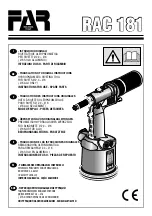
4
2.2) Installation procedure for AR61, AR65, AR6116, AR6516 rail web electrical connections
–
Drill rail web or,
if already drilled, use a suitable reamer to clean the hole
(Fig. 1).
–
Check the size of the hole with the
CAL 22.23
“GO/NO GO” gauge (Fig. 2a):
- The hole size is correct
if only the green part enters the hole.
-
If the red part enters, the hole is too large
, in this case
it is necessary to drill a new hole.
Using the same gauge, check the rail thickness (Fig. 2b):
- If the yellow band protrudes, use the
AR65...
series.
- If the yellow band does not protrude, use the
AR61....
series.
–
Insert the
AR...-1
copper bush into the rail web hole (Fig.
3
).
–
Ensure that the ram in the head is fully retracted and then fi rmly screw and tighten the stem of the
plunger onto the tool head (Fig. 4).
–
Introduce the stem of the plunger into the
AR...-1
copper bush from the unfl anged side and screw and
tighten the insert of the plunger
OG...
onto the stem (Fig.
5
) u
sing the recess in the gauge
CAL22.23.
Plungers OG13.2T and OG16.2T are composed of 2
separate items: insert and stem.
To rapidly execute subsequent extrusion operations, it
is
suffi
cient to unscrew the insert, leaving the stem fi rmly
screwed onto the head.
–
Operate the moveable handle of the tool (Fig. 6) to pull the plunger
OG... completely
through the
bush and extrude the bush onto the surface of the hole.
At the end of the operation, press the pressure release lever (20) to retract the ram (01).
–
The bush will also extrude itself around the opposite side of the rail web (Fig. 7).
2.3) Conductor assembly
–
Crimp the lug onto the conductor.
–
Assemble all pieces as shown in Fig. 8.
–
Fit the self-locking nut (Fig. 9) and tighten to the torque setting indicated.
insert stem
FIG. 2a
NO
YES
FIG. 1
FIG. 2b
yellow band
red part
green part


































